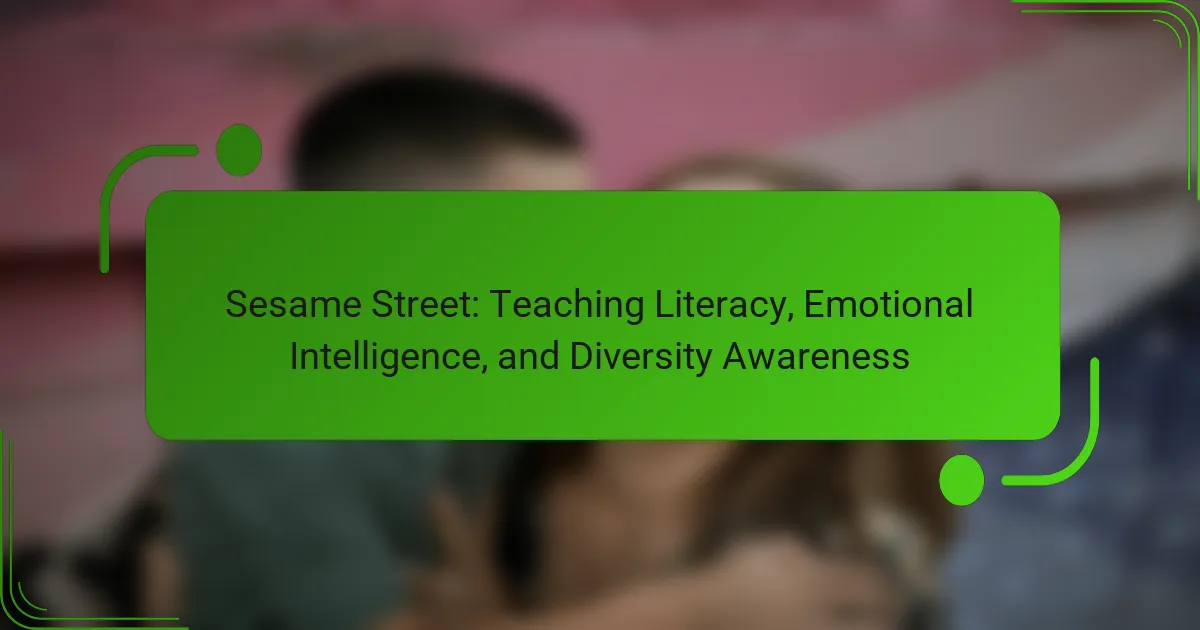Sesame Street is an educational children’s television program that has been instrumental in enhancing literacy, emotional intelligence, and cultural awareness since its debut in 1969. The show employs a mix of puppetry, animation, and live-action to engage preschoolers in learning essential skills such as reading, math, and social-emotional development. Research indicates that children who watch Sesame Street demonstrate improved academic performance and school readiness. The program’s commitment to diversity and inclusion is reflected in its characters and storylines, promoting an understanding of different cultures. Future initiatives will focus on digital learning and expanding resources for social-emotional education, further aligning with contemporary educational needs.

What is Sesame Street and its educational mission?
Sesame Street is an educational children’s television program that premiered in 1969. Its mission is to provide an engaging learning experience for preschoolers. The show focuses on developing literacy, numeracy, and social-emotional skills. Sesame Street uses puppetry, animation, and live-action to teach these concepts. The program aims to prepare children for school and life. It promotes diversity and inclusion through its characters and storylines. Research shows that Sesame Street significantly improves children’s school readiness. Studies indicate that children who watch the show perform better academically than those who do not.
How does Sesame Street approach teaching literacy?
Sesame Street approaches teaching literacy through engaging, interactive content. The program uses songs, puppetry, and storytelling to capture children’s attention. Each episode integrates phonics, vocabulary, and comprehension skills. Characters like Elmo and Big Bird model reading behaviors. Research shows that these methods enhance early literacy development. The curriculum aligns with educational standards for preschool literacy. Additionally, Sesame Street incorporates diverse narratives to reflect various cultures. This approach fosters both literacy and social-emotional learning in young viewers.
What specific literacy skills does Sesame Street focus on?
Sesame Street focuses on several specific literacy skills. These skills include phonemic awareness, vocabulary development, and comprehension. Phonemic awareness involves recognizing and manipulating sounds in words. Vocabulary development enhances children’s understanding of word meanings and usage. Comprehension skills help children understand and interpret stories and information. Research shows that these skills are essential for reading success. The show’s curriculum is designed to promote these skills through engaging characters and storylines.
How are these literacy skills integrated into the show’s content?
Literacy skills are integrated into the show’s content through interactive storytelling and character dialogues. Each episode features narratives that encourage vocabulary development and comprehension. Characters often engage in rhyming and wordplay, making language fun and accessible. Visual aids, such as letters and words displayed on screen, reinforce these concepts. The show also incorporates songs that emphasize phonemic awareness. Activities encourage viewer participation, promoting active learning. Research indicates that such methods enhance early literacy skills in children. Studies show that children who watch educational programming like Sesame Street perform better in reading readiness.
What role does emotional intelligence play in Sesame Street’s curriculum?
Emotional intelligence is a fundamental component of Sesame Street’s curriculum. It helps children recognize and understand their own emotions. The curriculum integrates lessons on empathy, self-regulation, and social skills. Characters model emotional awareness through relatable scenarios. For instance, Elmo and Abby Cadabby often express their feelings openly. This encourages children to articulate their emotions. Research shows that emotional intelligence contributes to better social interactions. Studies indicate that children with high emotional intelligence perform better academically. Sesame Street’s approach fosters a generation of emotionally aware individuals.
How does Sesame Street define emotional intelligence for children?
Sesame Street defines emotional intelligence for children as the ability to recognize, understand, and manage their own emotions, as well as the emotions of others. This definition emphasizes the importance of empathy, self-regulation, and social skills in children’s development. Sesame Street incorporates emotional intelligence into its programming through relatable characters and storytelling. These methods help children learn how to express their feelings and respond to the feelings of others. Research shows that early emotional intelligence is linked to better social relationships and academic success.
What activities promote emotional intelligence among viewers?
Activities that promote emotional intelligence among viewers include role-playing, storytelling, and interactive discussions. Role-playing allows viewers to experience different perspectives and emotions. Storytelling helps viewers connect with characters and their feelings. Interactive discussions encourage sharing and understanding of emotions. Research shows that these activities enhance empathy and emotional awareness. For instance, a study by Brackett et al. (2013) found that children who engage in such activities demonstrate higher emotional intelligence. These methods are effective in fostering emotional skills in a supportive environment.
How does Sesame Street foster diversity awareness?
Sesame Street fosters diversity awareness through inclusive storytelling and diverse character representation. The show features characters from various backgrounds, including different races, abilities, and cultures. This representation allows children to see themselves and others in the characters they watch. Educational segments address themes of acceptance, empathy, and understanding differences. For example, episodes have tackled topics like disabilities and cultural traditions. Research indicates that early exposure to diversity in media promotes positive attitudes towards others. This approach helps children develop social skills and emotional intelligence. Sesame Street’s commitment to diversity is evident in its long history of addressing relevant social issues.
What themes of diversity are explored in Sesame Street episodes?
Sesame Street explores various themes of diversity, including race, culture, abilities, and family structures. The show features characters from different ethnic backgrounds, promoting cultural awareness and acceptance. Episodes often address disabilities, showcasing characters with unique abilities and encouraging empathy. Additionally, Sesame Street includes diverse family dynamics, such as single-parent households and same-[censured] parents. This representation helps children understand and appreciate differences. The show’s commitment to diversity is evident in its storylines and character interactions, fostering inclusivity and respect.
How does Sesame Street represent different cultures and backgrounds?
Sesame Street represents different cultures and backgrounds through diverse characters and storylines. The show features a variety of ethnicities, including African American, Hispanic, Asian, and Middle Eastern characters. Each character brings unique cultural perspectives and experiences. For example, characters like Rosita and Elmo celebrate their cultural traditions. The show addresses social issues relevant to various communities, promoting inclusivity. Educational segments often highlight cultural practices, languages, and customs. Research indicates that Sesame Street’s approach fosters acceptance and understanding among children. This representation encourages viewers to appreciate diversity from a young age.
How do the elements of literacy, emotional intelligence, and diversity awareness connect in Sesame Street?
Sesame Street connects literacy, emotional intelligence, and diversity awareness by integrating these elements into its educational framework. Literacy is promoted through engaging stories and songs that encourage reading and comprehension skills. Emotional intelligence is fostered by character interactions that teach empathy, self-regulation, and social skills. Diversity awareness is highlighted through representation of various cultures, backgrounds, and experiences among characters. The show’s format allows children to learn about differences while developing critical thinking and communication skills. Research shows that Sesame Street’s approach effectively enhances children’s social-emotional development and academic readiness. Studies indicate that children who watch the show exhibit improved literacy and emotional understanding compared to those who do not.
What are the key strategies used by Sesame Street to engage children in learning?
Sesame Street engages children in learning through a combination of interactive storytelling, music, and puppetry. These strategies create an entertaining environment that captivates young audiences. The use of relatable characters helps children connect emotionally with the content. Research shows that children learn better when they are emotionally engaged. Additionally, Sesame Street incorporates repetition and reinforcement of concepts. This method aids retention and understanding of educational material. The show’s diverse representation promotes inclusivity and teaches social skills. Studies indicate that early exposure to diversity positively impacts children’s attitudes. Overall, Sesame Street effectively uses these strategies to foster a love for learning.

What impact has Sesame Street had on children’s education?
Sesame Street has significantly impacted children’s education by enhancing literacy, emotional intelligence, and cultural awareness. The program uses engaging characters and storytelling to teach foundational reading and math skills. Studies show that children who watch Sesame Street score higher on school readiness assessments. Research from the Journal of Applied Developmental Psychology indicates that Sesame Street improves vocabulary and fosters social-emotional skills. Its diverse representation helps children understand and appreciate different cultures. The show’s innovative educational strategies have influenced early childhood education practices globally.
How has Sesame Street influenced literacy development in young children?
Sesame Street has significantly influenced literacy development in young children. The program uses engaging characters and storytelling to teach letters, sounds, and vocabulary. Research shows that children who watch Sesame Street exhibit improved early reading skills. A study by the Joan Ganz Cooney Center found that children who watched the show had a greater understanding of phonemic awareness. The show’s format encourages active participation, which reinforces learning. Additionally, Sesame Street introduces diverse language and cultural contexts, enhancing comprehension. Its educational content aligns with early childhood literacy standards. Overall, Sesame Street effectively promotes literacy through entertaining and educational methods.
What research supports Sesame Street’s effectiveness in teaching literacy?
Research supports Sesame Street’s effectiveness in teaching literacy through various studies. A notable study by the National Institute for Early Education Research found that children who watched Sesame Street had better literacy skills than those who did not. The study indicated a significant increase in vocabulary and letter recognition among viewers. Another research by the University of California, Los Angeles, highlighted that Sesame Street improved children’s readiness for school. Children exposed to the show demonstrated enhanced phonemic awareness and comprehension skills. Additionally, a meta-analysis published in the journal “Child Development” confirmed the positive impact of educational television, including Sesame Street, on early literacy development. These studies collectively affirm Sesame Street’s role in fostering literacy among preschool-aged children.
How do parents and educators perceive the show’s impact on literacy?
Parents and educators generally perceive “Sesame Street” as having a positive impact on literacy. They believe the show effectively introduces foundational reading skills. Characters and storylines engage children in a fun and educational manner. Research indicates that children who watch the show demonstrate improved vocabulary and comprehension skills. A study by the Joan Ganz Cooney Center found that preschoolers who watched “Sesame Street” scored higher on literacy assessments. Educators report that the show’s interactive format encourages participation and learning. Parents appreciate the incorporation of diverse characters which enhances cultural understanding alongside literacy. Overall, the consensus highlights the show’s significant role in early literacy development.
In what ways has Sesame Street contributed to emotional development?
Sesame Street has significantly contributed to emotional development in children. The show introduces characters that model a range of emotions. These characters express feelings such as joy, sadness, and frustration. This helps children identify and understand their own emotions. Sesame Street also incorporates problem-solving scenarios that encourage emotional regulation. For example, episodes often depict conflict resolution and empathy. Research shows that children who engage with the program exhibit improved social-emotional skills. The show’s consistent focus on diversity fosters inclusivity and understanding of different perspectives. By addressing emotional concepts in relatable ways, Sesame Street effectively supports emotional growth in its young audience.
What evidence exists that shows Sesame Street improves emotional intelligence?
Research indicates that Sesame Street enhances emotional intelligence in children. A study published in the journal “Child Development” showed that children who watched Sesame Street exhibited improved emotional understanding. The study found that these children were better at recognizing emotions in themselves and others. Additionally, they demonstrated increased empathy and social skills. Another research conducted by the Joan Ganz Cooney Center revealed that Sesame Street characters model emotional regulation and problem-solving. This modeling helps children learn to navigate their feelings effectively. Overall, these findings support the conclusion that Sesame Street positively impacts emotional intelligence in its viewers.
How do children respond to emotional learning through the show?
Children respond positively to emotional learning through the show “Sesame Street.” They engage with characters that model emotional expression and empathy. This interaction helps children recognize and understand their own feelings. Research indicates that children who watch the show demonstrate improved emotional intelligence. Studies show that these children can better identify emotions in themselves and others. “Sesame Street” introduces emotional vocabulary, enhancing children’s ability to articulate their feelings. The show’s use of relatable scenarios fosters discussion about emotions among peers. Overall, the show’s approach effectively supports emotional learning in young viewers.
How has Sesame Street addressed issues of diversity in its programming?
Sesame Street has addressed issues of diversity in its programming through intentional character representation and storylines. The show features a diverse cast, including characters of different ethnicities, abilities, and backgrounds. For example, the introduction of characters like Julia, a Muppet with autism, promotes understanding and acceptance of neurodiversity. Sesame Street also tackles social issues, such as racism and inclusion, through engaging narratives and songs. In 2017, the show launched the “Sesame Street in Communities” initiative, focusing on resources for families to discuss diversity. This commitment to diversity has been recognized by organizations like the NAACP, which praised the show for its educational impact.
What feedback have communities provided regarding Sesame Street’s diversity initiatives?
Communities have generally provided positive feedback regarding Sesame Street’s diversity initiatives. Many parents appreciate the show’s commitment to representation. They note that diverse characters help children understand and accept differences. Feedback often highlights the importance of inclusivity in educational content. Some community members express that these initiatives foster empathy and social awareness. Research indicates that exposure to diverse narratives enhances children’s social skills. Overall, the initiatives are seen as a step forward in promoting equality and understanding.
How does Sesame Street adapt its content to reflect societal changes?
Sesame Street adapts its content to reflect societal changes by incorporating relevant social issues into its storylines. The show addresses topics like diversity, inclusion, and mental health. For instance, it introduced characters with different backgrounds and abilities. This approach promotes understanding and empathy among young viewers. Research shows that these themes resonate with children and parents alike. In 2020, Sesame Street launched initiatives related to the COVID-19 pandemic, providing resources for families. Such adaptations demonstrate the show’s commitment to being a responsive educational tool.

What are the future directions for Sesame Street’s educational initiatives?
Sesame Street’s future directions for educational initiatives focus on enhancing digital learning and inclusivity. The program aims to integrate technology to reach children through mobile apps and online platforms. These digital tools will provide interactive content tailored to individual learning styles. Additionally, Sesame Street is committed to addressing social-emotional learning. This includes developing resources that help children manage emotions and build resilience. The initiative will also expand its focus on diversity and inclusion. New content will reflect a wider range of cultures and experiences. This approach aligns with current educational needs for social awareness. Furthermore, ongoing partnerships with educational organizations will strengthen these initiatives.
How is Sesame Street evolving to meet the needs of modern audiences?
Sesame Street is evolving by integrating digital platforms into its educational content. The show now offers interactive apps and online resources for children. These tools enhance engagement and learning outside traditional TV viewing. Sesame Street also addresses contemporary social issues, such as diversity and emotional intelligence. Recent seasons feature characters that reflect various backgrounds and experiences. This inclusivity teaches children about empathy and understanding. The show’s content is regularly updated to resonate with current events and societal changes. Research shows that these adaptations keep Sesame Street relevant and effective for today’s audiences.
What new topics are being introduced to enhance literacy, emotional intelligence, and diversity awareness?
New topics being introduced include social-emotional learning, empathy, and multiculturalism. These topics aim to enhance literacy and emotional intelligence among children. Social-emotional learning focuses on understanding emotions and developing interpersonal skills. Empathy teaches children to recognize and share the feelings of others. Multiculturalism promotes awareness and appreciation of diverse cultures. Research indicates that these topics improve children’s social skills and emotional well-being. Programs integrating these themes have shown positive impacts on learning outcomes. Sesame Street is actively incorporating these topics into its curriculum to foster a more inclusive learning environment.
What practical tips can parents use to extend Sesame Street’s lessons at home?
Parents can extend Sesame Street’s lessons at home by incorporating playful learning activities. Engage children in storytelling using puppets to enhance literacy skills. Encourage them to express emotions through art, promoting emotional intelligence. Use diverse books to teach about different cultures and perspectives. Create simple math games using household items to reinforce counting and problem-solving. Discuss feelings and scenarios from episodes to foster empathy. Involve children in cooking to practice following instructions and measuring. Regularly watch episodes together and discuss the lessons learned to deepen understanding.
Sesame Street is an educational children’s television program that has been instrumental in teaching literacy, emotional intelligence, and diversity awareness since its debut in 1969. The show employs engaging methods such as puppetry, animation, and storytelling to develop essential skills in preschoolers, including phonemic awareness, vocabulary, and social-emotional learning. It promotes inclusivity through diverse character representation and addresses relevant social issues, enhancing children’s understanding of different cultures and perspectives. Research supports Sesame Street’s effectiveness in improving school readiness and emotional intelligence, making it a vital resource for early childhood education.
